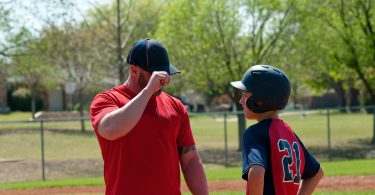Fundamental misunderstandings about college baseball scholarship opportunities can lead parents and recruits to make some poor decisions in the recruiting process. The quest for scholarship money often leads parents to over-spend on “exposure” events. In reality, most players would benefit more from putting that money towards development and academic assistance.
There is a running joke among college coaches about parents who spend thousands of dollars for their kids to chase scholarships at showcase after showcase and event after event. The coaches see the same players over-and-over during a short period of time and they can’t help but shake their heads at parents spending the equivalent of full tuition chasing a scholarship that often isn’t big enough to cover the full cost of tuition. Sounds like a bad business deal, doesn’t it?
We understand that as a parent, you are forced to make tough choices on how to spend your money. You want your son to be happy and have the best opportunity to get recruited. The hardest part is that most parents simply don’t know which are necessary costs and which are not. In this article and in future posts, we want you to understand your options when spending money for the purpose of giving your child a chance to play college baseball. In other words, we want your child to have the opportunity to play college baseball and we want you to know that you don’t have to spend a fortune to help him achieve his dreams.
To get started, we want you to understand more about what every college-bound player is chasing—scholarships! Everyone is chasing scholarships, but how much will your son benefit financially from a scholarship? How much of college costs does a typical scholarship cover? Let’s take a look at 8 quick facts about scholarships.
Understanding Baseball Scholarships
- College baseball is not a “head count” scholarship sport like football or basketball where every scholarship is an all-encompassing ‘full-ride’. Baseball operates on “equivalency” scholarship system where partial scholarships are spread over a larger number of players (For example, D1 programs can spread 11.7 scholarships among 32 athletes). Each scholarship typically covers a fraction of the cost of attendance (total estimated cost of attending school for 1 school year).
- Baseball scholarship money may be coupled with academic money and financial aid to create a larger overall package for players, but the NCAA monitors and limits the amount of baseball scholarships allowed and also has its own standards for non-countable (towards baseball scholarship) academic aid to create a more level playing field. For example, it would be difficult for someone with low GPA and test scores to have academic money that doesn’t count against the NCAA limit. This creates a more even playing field despite different institutions having different academic requirements.
- Scholarships are calculated as a proportion of the costs of attendance at each school: (Baseball Scholarship Money Granted)/(Total Cost of Attendance)= NCAA equivalency % or % value of scholarship. For example: If the total cost of attendance is $20,000 and you receive $10,000 in a baseball scholarship, you are on a 50% scholarship and count for .5 towards the NCAA maximum number of scholarships.
- Division 1 schools have an NCAA maximum of 11.7 full scholarships to divide up among a max of 32 scholarship players and a max of 35 guaranteed team roster spots. At present, if a player is going to be on baseball scholarship, they must be on at least .25 (25%) baseball money.
- Division II schools have an NCAA maximum of 9 scholarships to give out and no roster limits.
- Division III schools do not give out athletic scholarships and instead financial packages are based around need-based aid and academic money.
- Beyond the scholarship limits enforced by the NCAA, each program prioritizes different positions. Pitching, for example, is often prioritized and can take up 50-70% of total scholarship money allotted to a school in a given year.
- A glance at the allotment of scholarships for one D1 team revealed that most baseball scholarships covered in the range of 25-55% of the cost of attendance, with only a few outside of that range. While every school is different, this is a fairly typical percent range covered by baseball scholarships.
Necessary Versus Luxury Exposure
It’s true that if you want to play college baseball, coaches need to see you play. Fortunately, technology has made it easier and cheaper than ever for you to “get in front” of college coaches. Before writing a big check to send your player to a showcase or event, seek out free forms of evaluation and feedback. Here’s what that may look like:
Step 1: Create a DIY recruiting video and put together an introductory email.
Step 2: Send your video to programs of interest through a personalized email or social media DM.
Step 3: Gauge the response to your emails/social media. Are coaches responding? Are they interested? Do they want to see you play? Once you know who has interest, you can target events with coaches in attendance who have already evaluated your video and who you know are already interested in seeing you in person.
By running through this 3-step process, you can now target your exposure to programs that already see your skill set as a potential fit for their program. You’ll avoid wasting money on events with programs that your skill set doesn’t fit. You’ll recognize events or opportunities where you can get in front of coaches who want to see you play. Your money goes farther, and your chances of meaningful exposure skyrocket.
Balancing Exposure and Spending
As you can see, baseball is not a full ride sport. Combining baseball money with academic aid is often that the best way to make college more affordable for a student-athlete. Don’t fall for the exposure event hype. While exposure events can and do get players recruited, doing some homework and prep-work can help you save money and select events to attend that will give you the best chance at getting interest. Don’t let industry fear tactics or deceitful advertising fool you, the best return on the money you spend on your son often centers around developing a recruitable skill set and academics. Making sure he has strong test scores and grades is the best place to start. This will not only keep his options open for more schools, it will also increase his chances of getting much more substantial aid from non-baseball sources.
For more information on college baseball scholarships, click here.







